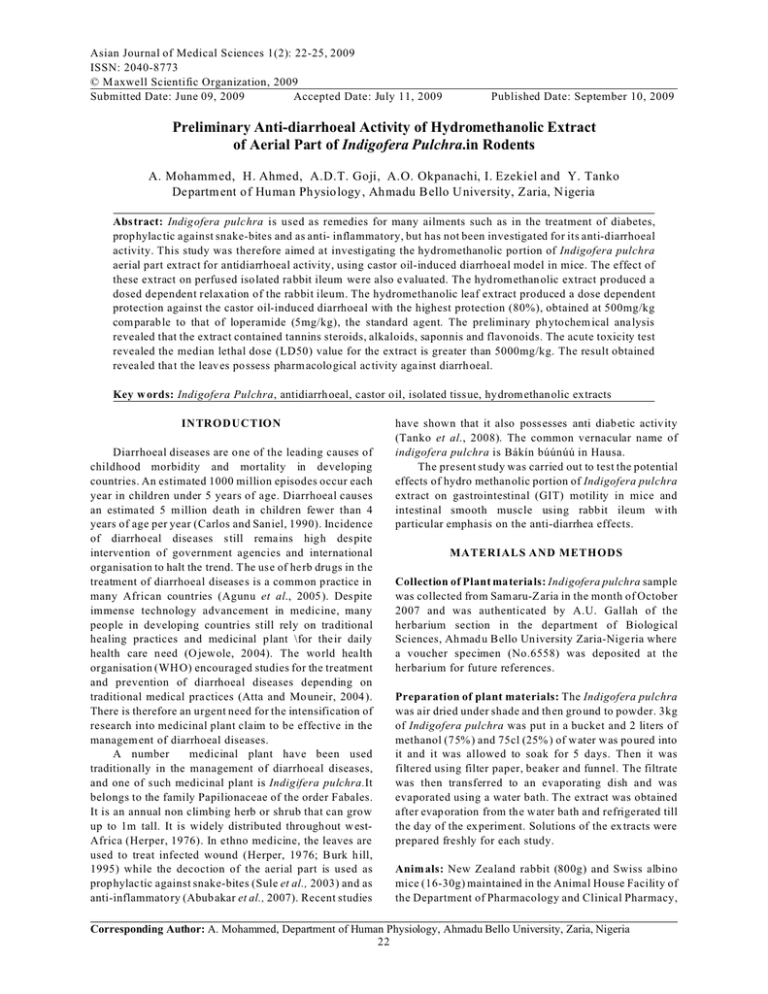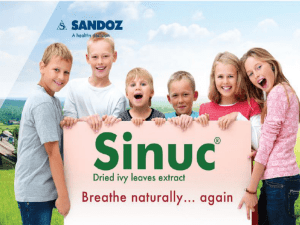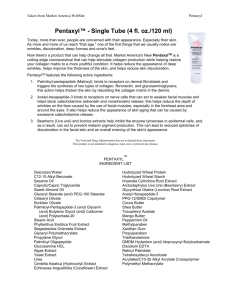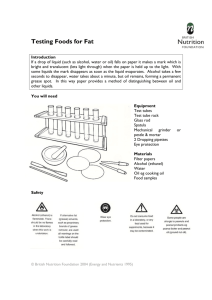Asian Journal of Medical Sciences 1(2): 22-25, 2009 ISSN: 2040-8773
advertisement

Asian Journal of Medical Sciences 1(2): 22-25, 2009 ISSN: 2040-8773 © M axwell Scientific Organization, 2009 Submitted Date: June 09, 2009 Accepted Date: July 11, 2009 Published Date: September 10, 2009 Preliminary Anti-diarrhoeal Activity of Hydromethanolic Extract of Aerial Part of Indigofera Pulchra.in Rodents A. Mohamm ed, H. Ahmed, A.D.T. Goji, A.O. Okpanachi, I. Ezekiel and Y. Tanko Departm ent of Human Ph ysiology , Ahmadu B ello U niversity, Zaria, Nigeria Abstract: Indigofera pulchra is used as remedies for many ailments such as in the treatment of diabetes, prophylac tic against snake-bites and as anti- inflammatory, but has not been investigated for its anti-diarrhoeal activity. This study was therefore aimed at investigating the hydromethanolic portion of Indigofera pulchra aerial part extract for antidiarrhoeal activity, using castor oil-induced diarrhoeal model in mice. The effect of these extract on perfused isolated rabbit ileum were also e valua ted. Th e hyd romethan olic extract produced a dosed dependent relaxation of the rabbit ileum. The hydromethanolic leaf extract produced a dose dependent protection against the castor oil-induced diarrhoeal with the highest protection (80%), obtained at 500mg/kg com parab le to that of loperamide (5mg/kg), the standard agent. The preliminary phytochem ical ana lysis revealed that the extract contained tannins steroids, alkaloids, saponnis and flavonoids. The acute toxicity test revealed the median lethal dose (LD50) value for the extract is greater than 5000mg/kg. The result obtained revea led that the leav es possess pharm acolo gical ac tivity aga inst diarrh oeal. Key w ords: Indigofera Pulchra, antidiarrh oeal, castor oil, isolated tissue, hy drom ethan olic extracts INTRODUCTION Diarrhoeal diseases are one of the leading causes of childhood morbidity and mortality in developing countries. An estimated 1000 million episodes occur each year in children under 5 years of age. Diarrhoeal causes an estimated 5 m illion death in children fewer than 4 years of age per year (Carlos and Saniel, 1990). Incidence of diarrho eal diseases still rema ins high despite intervention of government agencies and international organisation to halt the trend. T he use of herb drugs in the treatment of diarrhoeal disease s is a comm on practice in many African countries (Agunu et al., 2005 ). Despite immense technology advancement in medicine, many people in developing countries still rely on traditional healing practices and medicinal plant \for the ir daily health care need (O jewole, 2004). The world health organisation (WH O) encouraged studies for the treatment and prevention of diarrhoeal diseases depending on traditional medical practices (Atta and Mo uneir, 2004). There is therefore an urgent need for the intensification of research into medicinal plant claim to be effective in the managem ent of diarrhoeal diseases. A number medicinal plant have been used traditionally in the management of diarrhoeal diseases, and one of such medicinal plant is Indigifera pulchra.It belongs to the family Papilionaceae of the order Fabales. It is an annual non climbing herb or shrub that can grow up to 1m tall. It is widely distribu ted throughout w estAfrica (Herper, 1976). In ethno medicine, the leaves are used to treat infected wound (Herper, 19 76; B urk hill, 1995) while the decoction of the aerial part is used as prophylac tic against snake-bites (Sule et al., 2003) and as anti-inflammatory (Abub akar et al., 2007). Recent studies have shown that it also possesses anti diab etic activity (Tanko et al., 2008). The common vernacular name of indigofera pulchra is Bákín búúnúú in Hausa. The present study was carried out to test the potential effects of hydro methanolic portion of Indigofera pulchra extract on gastrointestinal (GIT) motility in mice and intestinal smooth muscle using rabbit ileum w ith particular emphasis on the anti-diarrhea effects. MATERIALS AND METHODS Collection of Plant ma terials: Indigofera pulchra sample was collected from Sam aru-Zaria in the month of October 2007 and was authenticated by A.U. Gallah of the herbarium section in the department of Biological Sciences, Ahmad u Bello University Zaria-Nige ria where a voucher specimen (No.6558) was deposited at the herbarium for future references. Preparation of plant materials: The Indigofera pulchra was air dried under shade and then gro und to powder. 3kg of Indigofera pulchra was put in a bucket and 2 liters of methanol (75%) and 75cl (25% ) of water w as poured into it and it was allowed to soak for 5 days. Then it was filtered using filter paper, beaker and funnel. The filtrate was then transferred to an evaporating dish and was evaporated using a water bath. The extract was obtained after evap oration from the water bath and refrigerated till the day of the experim ent. Solutions of the ex tracts were prepared freshly for each study. Anim als: New Zealand rabbit (800g) and Swiss albino mice (16-30g) maintained in the Animal House Facility of the Department of Pharmacology and Clinical Pharmacy, Corresponding Author: A. Mohammed, Department of Human Physiology, Ahmadu Bello University, Zaria, Nigeria 22 Asian J. Med. Sci., 1(2): 22-25, 2009 Ahm adu Bello University Z aria, Nigeria w ere used in these experiments. The animals were maintained on standard animal feed and w ater ad libitum. This research was carried out in Ahmad u Bello U niversity in accordance with the rules governing the use of laboratory animals as accepted internationally. three hours after castor oil challenge. The cages w ere inspected for the presence of the characteristic diarrhoea droppings. The absence was recorded as a protection from diarrhoea (Diurno, et al,. 1996) and the percentage protection w as calculated (A kah and Offiah, 1996). Statistical analysis: The results were analysed by chi square (X 2 ). Values were considered significant with P< 0.05 for both isolated tissue and castor oil induced diarrho ea. Drugs: Acetylcholine and Adrenaline (Sigma chemical, USA) Castor oil (Bell Sons and Co., England) and Loperamide (Janssen) P h y t o c h e m i c a l p r o c e d u r e : T h e p r e l im i n a ry phytochemical screening of the crude extract of Indigofera pulchra was carried out in order to ascertain the presence of its constituents by utilizing standard conventional protocols (Trease and Evans, 1989). RESULTS Phytochemical analysis: The preliminary phytochemical screening of the extract revealed the presence of alkaloids, saponins, flavonoids, tannins and steroids. Acu te Toxicity Study: The method previously described by Lorke (1983) was adopted using13 mice. In the first phase, three doses of the hydromethanolic extract (10, 100 and 1000m g/kg w ere adm inistered to three groups each containing three mice). In the second phase, more specific doses were administered to four groups each containing one mouse.The median lethal dose (LD 5 0 ) was determined as the geometric mean of the highest non lethal dose and lowest lethal dose of which there is 0/3 and 0 /1 survival. Acu te Toxicity study: The median lethal dose of the extract was found to be greater than 5000mg/kg bodyweight. Effects on isolated rabbit ileu m: The rabbit was made unconscious by a powerful strike at the back of the neck (stunning). The abdomen was immediately opened using forceps and part of the ileum was quickly removed. The ileum was introduced immediately into a Petri dish of saline containing Tyrode solution and each end of the ileum was tied with a thread. The ileum was then suspended into the organ bath, which contains supply of oxygen and air to the ileum in organ bath. One end of the ileum was attached to the transducer which measured the mechanical impu lse of the tissue and co nverted it to electrical impulses which was then recorded on microdyna mom eter. The temperature of the inner ba th was kept at temperature 37 0 c by the therm o regulator. Subsequently, solutions of acetylcholine and adrenaline Indigofera pulchra extracts w ere added at interva ls to the isolated perfuse chamber. After application of each drug, the tissue was w ashed three times with the Tyrode solution to remove every trace of the drug. Effect of Indigofera pulchra on castor oil induced diarr hoeal: The extract produced a dose dependent protection against the castor oil- induced diarrho eal w ith the highest protection (80%) obtained at the highest dose tested (500mg/k g) com parab le to that of loperamide, the .standard an ti diarrhoeal agent. Effect of hydro-me thanolic ex tract of Indigofera pulchra On isolated rabbit ileum: Fig. 2 showed the effects of the plant hydromethanolic extracts on the isolated rabbit ileum were dose related the extract relaxed the spontan eous contraction of the rabbit ileum . DISCUSSION The median lethal dose of the extract was greate r than 5000mg/ kg .bodyweight Castor oil causes diarrhea due to its active metabolite, ricinoleic ac id (Ammo,et al., 1974; Watson and Gordon,1962), which stimulates peristaltic activity in the small intestine, leading to changes in the electrolyte permeability of the intestinal mucosa. Its action also stimulates the release of endogenous prostaglandin (Galvez et al., 1993). Acetylcholine (Ach) cause increased contraction of the isolated jejunum as shown in Fig. 1. However, Indigofera pulchra significantly reduced intestinal transit time as observed by the decrease in intestinal motility of isolated rabbit jejunum as shown in Fig. 2. The relaxation effects of the extract is also similar to adrenalin as shown in Fig. 3. The effects of both the extract and adrenalin were blocked by propranolol,which is a beta blocker as shown in Fig. 4. This suggests that the extract may be acting via beta receptors . Phytochemical screening revealed the presence of alkaloids, tannins and sterols. Earlier studies show ed that anti-dysenteric and antidiarrhea properties of medicinal plants were due to tannins, alkaloids, saponins, flavonoids and sterols Effects of castor oil induced diarrhea in mice: The mice were fasted for 12hours prior to the commencement of the experiment and were randomly divided into five groups of five mice each. The mice in the first group received 10mlkg -1 norm al saline intraperitoneally w hile the mice in the second received 5mlkg-1 Loperamide as a standard positive control, the third, fourth and fifth 100, 250 and 500mg/kg, respectively. After 30 minutes of administration of the extract, castor oil 0.2ml/ mouse were administered orally. The animals were placed on individual special cages over w hite clean w hatman filter, 23 Asian J. Med. Sci., 1(2): 22-25, 2009 Fig. 4: Effects of Propanolol, Adrenaline and Indigofera Pulchra Extract on Isolated Rabbit Ileum Fig. 1: Effects of Acetylcholine (ug/ml) on isolated rabbit ileum Tab le 1: Effects of hydro-m ethanolic extract of Indigofera pulch ra on castor oil Induced diarrhoeal in mice Trea tmen t Dose (mg/kg) No of m ice w ith P ro te ctio n (% ) Diarrhoeal Normal saline 10ml/kg 5/5 0.0 Extract 100 3/5 40 Extract 250 2/5 60 Extract 500 1/5 80 Loperamide 5 0/5 100 Results were analyzed by Chi-square (X 2 ). Values were considered significant when P<0.05 compared with Normal saline group, n=5 Mice administered with 100, 250 and 500mg/kg hydromethanolic extract of Indigofera pulchra had d iarrhea in 3/5, 2/5 and 1/5 respectively (40, 60, and 80% protection respectively) as shown in Table 1 In this study, hyd ro-methan olic extract of Indigofera pulchra exhib ited a significant anti-diarrh eal activity. Its effect depended on the dose. The results were similar to that of the standard dru g Loperam ide 5m g/kg w ith regard to the severity of diarrhea. The observed relaxation exhibited by the leaves extract further explains its ability to p rotect the mice again st diarrhe a indu ced b y castor oil. Fig. 2: Effect of Hydrometh anolic extract of aerial part of Indigofera pulchra on isolated rabbit ileum REFERENCES Abu bakar, M .S., A .M . M usa, A . A hmed and I.M. Husaini, 2007. The perception and practice of traditional medicine in the treatment of cancers and inflammations by the Hausa and Fulani tribes of Northern Nigeria. J. Ethnopharmac ol., 111(3): 625-629. Agunu, A., S. Yusuf, G.O. Andrew, A.U. Zezi and E.M. Abdulrahman, 2005. Evaluation of five medicinal plants used in diarrhoeal treatment in Nigeria. J. Ethnopharmacol., 100: 27-30. Atta, A.H . and S .M. Mouneir, 2004. Antidiarrhoeal activity of some Egyptian medicinal plant extracts. J. Ethnopharmacol., 92: 303-309. Ammo, P., J. Thomas and S. Philips, 1974. Effects of oleic and recinoleic acids net jejunal water and electrolyte movement. J. Clin. Invest., 53: 374-379. Fig. 3:Tthe effect of hy drom ethan olic extract of aerial part of Indigofera pulchra and A drenaline on rabbit ileum (Galvez et al., 1991; Loganga et al., 2000). Hence, tannins, sterols, alk aloids may be responsible for the mechanism of action of Indigofera Pulchra anti-diarrhea activity. The anti-diarrhea activity of this extract may also be due to the presence of denatured proteins, which form protein tannates. Protein tannates make the intestinal mucosa more resistance and hence, reduc e secretion. T his can be due to the fact that the extract increased the reabsorption of by d ecreasing intestinal m otility in isolated rabbit ileum. 24 Asian J. Med. Sci., 1(2): 22-25, 2009 Carlos, C.C . and M .C. Sa niel, 1990. Etiology and Epidemiology of diarrhoeal. Philipp. J. M icrobio l. Infect. Dis., 19(2): 51-53. Diurno, M.V., A.A. Izzo, B. Mazonni, A. Bologgnese and F. Caspasso, 1996. Anti diarrhea activity of new thiazolinones related to Loperam ide. J. Pharmacy Pharmacol., 48: 760-762. Galvez, J., A. Zarzuelo and M.E. Crespo, 1991. Antidiarrhoeal activities of scleroarya birrea bark extract and its active tannin constituent in rats. Phytother. Res., 5: 276-278. Galvez, J., A. Zarzue lo, M .E. Crespo, M.D. Lorento, M.A. Ocete and J. Jimenez , 1993 . Antidiarrhoeic activity of Euphorbia hirta extract and isolation of an active flavonoid constituent. Planta Medica, 59: 333-336. Herpe r, F.N., 1976. The We st African Herbaria of Isert and Thoning. Bentham-moxin trust in association with Carlsberg foundation, Kew, England. pp: 92 Lorke, D., 1983. A new approach to practical acute toxicity testing. Arch. Toxicol., 54: 275-287. Akah, P.A. and V.N. Offiah, 1996. Gastrointestinal effect of Allamanda cathartica leaf extract. Int. J. Pharmacogn., 30, 213-217 Trease, G.E. and M.S. Evans, 1989. Textbook of Pharmacognosy. 14 th Edn., Balliere Tindall, London, pp: 81-90, 269-275, 30. Ojewole, J.A.O ., 2004 . Evaluation of the Antidiabetic, Anti inflammatory and Antidiabetic properties of sclerocarya birrea (A. Rich) H ochst. Stem bark aqueous Extract in M ice and Rats. Phytother. Res., 18: 601-608 Loganga, O.A ., A. Vercruysse and A. Foriers, 2000. Contribution to the ethanobotanical, phytochemical and pharma cology stud ies of traditionally used medicinal plant in the treatment of dysentery and diarrhoeal in Lomela area, Democratic Republic of Congo (DRC ). J. Ethnopharmacol., 71(3): 41-423. Sule, M.I., U.U . Pateh, A.K. Haruna, M. Garba, A.A. Ahmadu and A.K. Adamu, 2003. Plants used in Hausa traditiona l medicine in N orthern Nigeria. J. Trop. Biosci., 3: 17-20. Tanko, Y., M.M. Abdelaziz, A.B. Adelaiye, M.Y. Fatihu and K.Y. M usa, 2008. Effects of N-Butanol portion of Indigofera pulchra leaves extract on blood glucose l e v e l s o f a l lo x a n - i n d u c ed d i a b e ti c a nd norm oglyc emic W istar rats. Eur. J. Scien tific Res., 22: 501-507. W atson, W.C. and R. Gordon, 1962. Studies on the digestion absorption and m etabo lism of castor oil. Biochem. Pharmacol., 11: 229-236. 25





